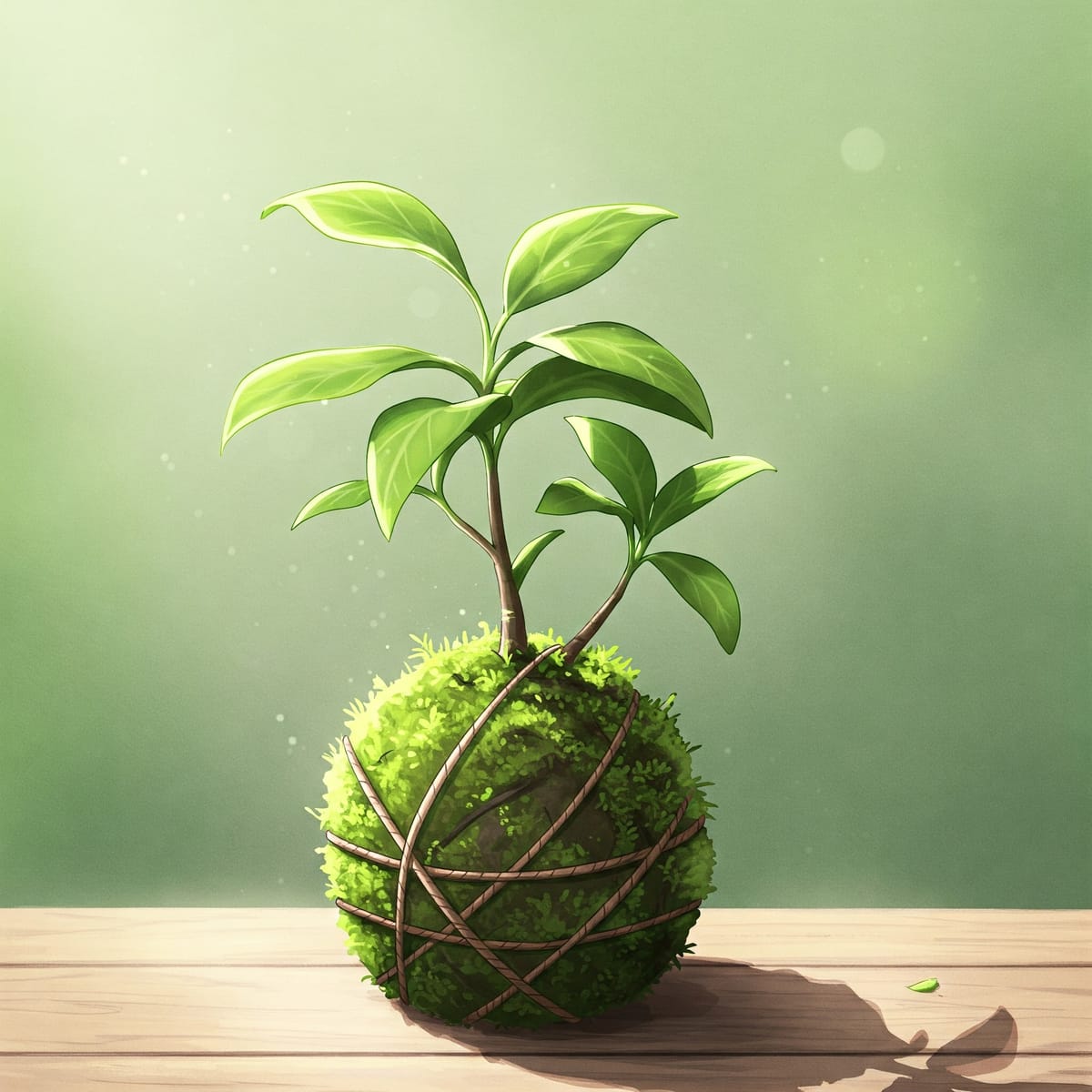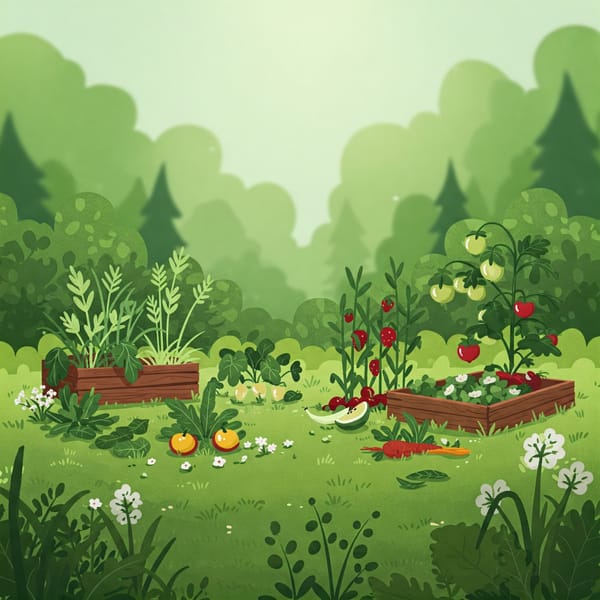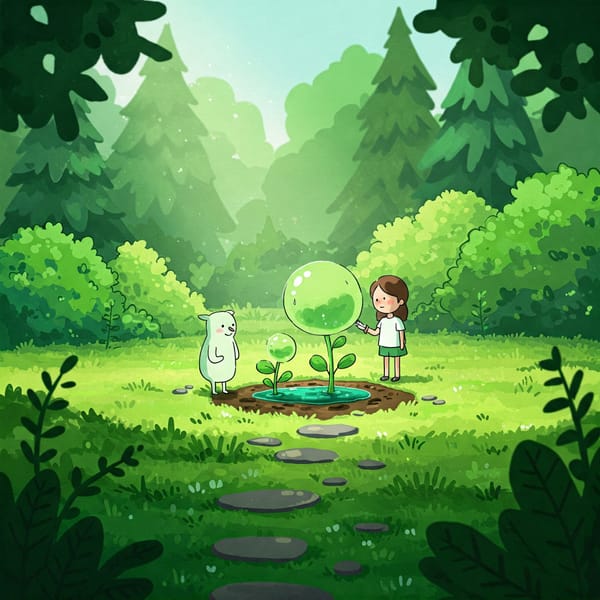Kokedama: Japanese Moss Ball Gardens

TLDR
Kokedama is a unique Japanese gardening art form where plants are grown in a moss-covered ball instead of a traditional pot. This technique, also known as "string gardening" or "air gardening," evolved from bonsai and offers a minimalist and accessible way to display plants. The process involves carefully selecting plants, preparing a soil mixture, encasing it in moss, and securing it with string. Kokedama can be displayed in various ways, including hanging or tabletop arrangements, and reflects Japanese aesthetic and philosophical principles like Wabi-Sabi.
Kokedama: Japanese Moss Ball Gardens
Kokedama, a captivating Japanese gardening art form, transforms ordinary plants into unique sculptural expressions by encasing their root systems in a sphere of moss, meticulously bound with string. The term itself is derived from the Japanese words "koke," meaning moss, and "dama," meaning ball. This art form has garnered increasing global popularity, celebrated for its minimalist aesthetic and its ability to seamlessly integrate greenery into indoor spaces. Departing from conventional potted plants, Kokedama offers a distinctive approach to plant display, often referred to as "string gardening" or "air gardening," where plants are suspended or presented without the traditional confines of a pot. Its accessibility further enhances its appeal, sometimes affectionately known as "poor man's bonsai" or "lazy man's bonsai," suggesting a simplicity and approachability that contrasts with the more demanding art of traditional bonsai.
The History of Kokedama
The origins of Kokedama are deeply intertwined with the rich history of Japanese horticulture, emerging as a fascinating derivative of the esteemed art of Bonsai. Specifically, Kokedama evolved from a broader Japanese gardening practice known as "nearai," which literally translates to "root wash". Nearai was a distinct style of bonsai where the tree's roots were meticulously cleaned and then planted in a pot without any soil. The intention behind this technique was that the roots would eventually naturally affix themselves to the interior of the pot. Over time, this practice underwent a transformation, gradually evolving into what is now recognized as Kokedama. The key difference lies in the treatment of the roots: instead of being placed directly into a pot, the roots are carefully encased in a ball of soil and then enveloped in moss.
The precise beginnings of Kokedama remain somewhat veiled in the mists of time, but it is widely believed that the practice originated in Japan during the Edo period (1603–1868). This era witnessed the rise of various art forms and gardening styles, and Kokedama emerged as a creative solution for the lower classes who wished to partake in the enjoyment of bonsai without the financial burden of acquiring expensive traditional ceramic pots. While one source suggests an origin approximately 500 years ago, which aligns with the later part of the Edo period, the underlying principle of appreciating nature in a simplified form resonates with the socio-economic context of that time. In more recent times, Kokedama has transcended its origins, experiencing a surge in popularity worldwide, particularly due to its inherent minimalist aesthetic and its suitability for bringing the tranquility of nature into indoor environments.
Essential Materials for Creating Kokedama
Creating a Kokedama involves a thoughtful selection of materials, each contributing to the final aesthetic and the plant's well-being. The essential components include various types of moss, specific soil mixtures, binding materials, and a few basic gardening tools.
Different types of moss serve distinct purposes in Kokedama creation. Sphagnum moss or peat moss is often incorporated into the soil mixture to enhance its ability to retain moisture. Sheet moss, which can be sphagnum sheet moss, preserved sheet moss, dry floral moss, or even harvested moss, is used as the outer covering of the soil ball. Different types of sheet moss offer a range of colors and textures, allowing for creative variation.
The selection of the soil mixture is crucial for the health of the plant within the Kokedama. A common base is a premium, soil-less, peat moss-based potting mix. Peat moss itself is frequently used in combination with other soils to improve moisture retention. Bonsai soil is often mixed with peat moss, typically in ratios of 3:7 or 1:1, to provide adequate drainage and structure to the soil ball. Akadama soil, a granular volcanic clay soil from Japan, is another component sometimes used, particularly in more traditional Kokedama mixes, for its ability to retain moisture while also ensuring good drainage.
To hold the moss securely around the soil ball, various binding materials are employed. Thick cotton string, twine, or fishing line are commonly used for this purpose. Waxed string or floral wire can also provide a more secure binding. Jute twine is another option, valued for its natural appearance and its ability to help shape the ball.
A few basic tools are also essential for the Kokedama creation process. These include a trowel and pruners for preparing the plant, as well as scissors for cutting moss and binding materials. Bowls are needed for mixing the soil components and for soaking the sheet moss in water. Naturally, water is a fundamental requirement for mixing the soil, hydrating the moss, and eventually watering the Kokedama.
Constructing Kokedama: A Step-by-Step Guide
Constructing a Kokedama is a rewarding process that combines horticultural skill with artistic sensibility. The initial stage involves preparing the soil ball. This typically begins by mixing the chosen soil components in a bowl. Common combinations include peat moss and bonsai soil in proportions such as 7:3 or 1:1, or other mixes incorporating clay or akadama soil. Water is then gradually added to the mixture while stirring until it reaches a consistency that allows it to be easily formed into a ball that holds its shape without crumbling.
Next, attention is turned to handling the plant's roots. The plant is carefully removed from its original pot, and most of the surrounding soil is gently removed from the root ball, taking care to loosen any tightly bound roots.
The process of wrapping with moss begins by dampening the sheet moss in warm water. This makes the moss more pliable and easier to work with. The prepared root ball is placed onto a piece of sheet moss, typically with the moss's face down. The sheet moss is then carefully gathered around the soil ball and up to the base of the plant, ensuring that all exposed soil surfaces are covered.
Finally, the moss-covered ball is secured with binding materials. This usually involves starting to wrap the ball with twine, string, or fishing line, leaving a generous tail of material at the beginning for tying off later. The binding material is wound around the ball in all directions to tightly secure the moss layer.
Selecting Suitable Plants for Kokedama
Choosing the right plant is fundamental to the success and longevity of a Kokedama. Several factors should be carefully considered when making this selection. Size is a primary consideration. Plants with naturally small root systems or those that exhibit slow growth habits are generally more suitable for the confined environment of a moss ball and tend to thrive in the long term. The water requirements of the plant are also crucial. Since the moss ball tends to retain moisture, plants that tolerate or even prefer consistently moist soil conditions are generally good candidates for Kokedama. The amount of light available in the intended display location must also be taken into account. Selecting plants that are appropriate for the specific light conditions (shade, partial shade, bright indirect light) is essential for their health.
Based on these factors, a wide variety of plant types are suitable for Kokedama. Shade-loving plants that thrive in low to medium light conditions include popular choices such as pothos, philodendron, African violet, begonia, various types of ferns, grape ivy, dracaenas, cyclamen, elephant's ears, peperomia, Jacob's ladder, prayer plant, creeping fig, snake plant, peace lily, trailing ivy, hoya, spider plant, anthurium, nerve plant, pilea, and purple waffle plant. For locations with full sun or part shade and bright indirect light, suitable options include kalanchoe, aloe, string-of-beads, wax plant, basil, thyme, mint, parsley, oregano, croton, English ivy, inch plant, Christmas cactus, donkey's tail, sedums, and rosemary. Tropical and vining plants generally appreciate higher humidity and more frequent watering, making them potentially suitable, with examples like philodendrons, palms, anthurium, peace lily, creeping fig, devil's ivy pothos, asparagus fern, and rhipsalis. Even orchids can be grown in Kokedama, provided they are planted using a specific orchid mix.
Conversely, there are some plant types that are generally best avoided for Kokedama. Cacti and most succulents are typically not recommended due to their preference for loose, sandy, well-draining soil, which is difficult to form into a stable moss ball.
Caring for Your Kokedama
Proper care is essential to keep your Kokedama thriving and looking its best. This involves understanding the correct watering techniques, light requirements, fertilization needs, and other maintenance practices. The most common method for watering a Kokedama is by soaking the entire moss ball in a bowl or sink filled with room-temperature water. This should be done for approximately 10 to 25 minutes, or until the moss ball feels fully saturated with water. The frequency of watering will depend on various factors, including the type of plant, the amount of light it receives, the humidity levels in the environment, and the season. Generally, watering is needed anywhere from once a week to once every two weeks.
The light requirements for a Kokedama are primarily dictated by the type of plant it contains. In general, most Kokedama plants thrive in bright, indirect light. Direct sunlight should be avoided, as it can scorch the moss and cause the plant to dry out too quickly.
Fertilization is important for providing the necessary nutrients to your Kokedama. During the active growing season, which typically spans from spring to summer, it is recommended to fertilize your Kokedama about once a month. This is usually done by adding a water-soluble indoor plant fertilizer to the water used for soaking, ensuring to use only half of the product's recommended concentration.
In addition to watering and light, other care tips can help maintain the health and appearance of your Kokedama. Misting the moss regularly can help to increase humidity and keep the moss vibrant green. Maintaining a comfortable temperature range between 60°F and 85°F is generally ideal for most plants in Kokedama. Regularly pruning any dead or yellowing leaves will not only improve the appearance of your Kokedama but also encourage new growth.
Exploring Styles and Applications of Kokedama
Kokedama's versatility extends beyond its basic form, offering numerous styles and applications that allow for creative expression and integration into various environments. One of the most popular ways to display Kokedama is through hanging displays, often referred to as "String Gardens". These can be suspended from ceilings, windows, or other structures using twine, string, or fishing line. Kokedama also lends itself well to tabletop arrangements. They can be placed on a variety of surfaces such as dishes, trays, saucers, bowls made of wood, ceramic, or clear materials, as well as on natural elements like stones, bark slabs, or cork slabs.
Beyond traditional hanging and tabletop displays, Kokedama can also be adapted for more unconventional applications. For instance, they can be incorporated into terrariums, creating miniature, self-contained ecosystems. In the realm of interior design, Kokedama offers a unique and artistic way to introduce greenery into living spaces. They can bring the serene atmosphere of a Japanese Zen garden indoorsand are versatile enough to complement a wide range of home décor styles.
While traditionally used with indoor plants, there is some exploration into the possibility of creating Kokedama for outdoor settings. However, it's important to note that outdoor Kokedama, especially those using hardy plants, might require more frequent watering and careful consideration of the plants' overwintering needs.
Significance and Symbolism of Kokedama in Japanese Culture
Kokedama is more than just a gardening technique; it is deeply rooted in Japanese culture and reflects key aesthetic and philosophical principles, most notably Wabi-Sabi. This philosophy emphasizes finding beauty in natural imperfections, simplicity, and the transient nature of life, all of which are embodied in the organic form and evolving appearance of a Kokedama.
Various symbolic meanings are associated with the moss ball form and the practice of Kokedama itself. The green moss ball is sometimes interpreted as a symbol of maternal love and charity. The spherical shape is believed to enhance the plant's natural essence and evoke a sense of peacefulness and Zen spirit. For those living in urban environments, Kokedama can represent a tangible connection to nature. Moss itself often symbolizes longevity, representing something that flourishes over time and in harmony with its surroundings. The creation of a Kokedama can also be seen as a symbolic act of balancing the controlled (the carefully formed moss ball) with the wild (the natural growth of the plant).
Kokedama's development as an accessible art form reflects the Japanese appreciation for nature that extends beyond formal practices like Bonsai. Having originated as an affordable alternative to the often costly art of Bonsai, it democratized the ability to enjoy miniature representations of nature. The practice aligns with the Japanese cultural inclination to recreate natural scenes within the home, fostering a sense of tranquility and connection to the environment.
Conclusion
In summary, Kokedama is a captivating Japanese gardening art form with a rich history, evolving from the practice of Nearai bonsai into a globally appreciated expression of horticultural artistry. It involves carefully encasing a plant's root system in a moss ball, bound with string, creating a unique sculptural piece that can be displayed in various ways, from hanging gardens to tabletop arrangements. The creation of a Kokedama requires attention to detail in selecting appropriate moss, soil mixtures, and binding materials, as well as following specific step-by-step instructions. Proper care involves understanding the plant's individual needs for watering, light, and fertilization. Beyond its practical aspects, Kokedama holds significant cultural value in Japan, reflecting principles of Wabi-Sabi and embodying symbolic meanings related to nature, longevity, and connection. Its accessibility compared to traditional bonsai has made it a popular way for people to bring the beauty and tranquility of nature into their homes.




